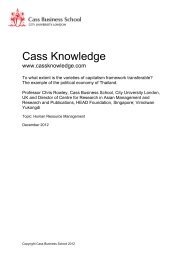A multi-stage model of governance in ... - Cass Knowledge
A multi-stage model of governance in ... - Cass Knowledge
A multi-stage model of governance in ... - Cass Knowledge
You also want an ePaper? Increase the reach of your titles
YUMPU automatically turns print PDFs into web optimized ePapers that Google loves.
<strong>Cass</strong> Centre for Pr<strong>of</strong>essional Service Firms – Work<strong>in</strong>g Paper 004 - 2010<br />
• An organization will pass through several <strong>stage</strong>s as it grows and matures.<br />
• Organizational solutions which are appropriate at a certa<strong>in</strong> <strong>stage</strong> <strong>in</strong> an<br />
organization’s growth will cease to be appropriate as it grows and matures.<br />
• Management may be slow to recognize the need for change until the<br />
underly<strong>in</strong>g problems become acute.<br />
• These problems may precipitate dramatic upheavals or ‘crises’.<br />
• At any <strong>stage</strong>, failure to deal with these issues may lead to the reversal or<br />
even death <strong>of</strong> the organization (the ultimate ‘failure to mature’).<br />
Gre<strong>in</strong>er asserts, therefore, that an organization passes through a specified series <strong>of</strong><br />
<strong>stage</strong>s <strong>of</strong> growth via alternat<strong>in</strong>g periods <strong>of</strong> evolution and revolution or, to use less<br />
dramatic language, an organization will experience periods <strong>of</strong> gradual development<br />
punctuated by periods <strong>of</strong> dramatic change. Gre<strong>in</strong>er, therefore, presents a ‘punctuated<br />
equilibrium’ <strong>model</strong> <strong>of</strong> organizational change (Gersick, 1991), consistent with the<br />
concept <strong>of</strong> tracks developed by Greenwood and H<strong>in</strong><strong>in</strong>gs (1988).<br />
Gre<strong>in</strong>er’s <strong>model</strong> was developed without reference to pr<strong>of</strong>essional service firms. He<br />
acknowledged this limitation <strong>in</strong> the 1998 revision to his 1972 article by allud<strong>in</strong>g to his<br />
ongo<strong>in</strong>g research <strong>in</strong>to law, consult<strong>in</strong>g and <strong>in</strong>vestment firms and subsequently<br />
presented a <strong>model</strong> <strong>of</strong> the <strong>stage</strong>s <strong>of</strong> growth <strong>in</strong> consult<strong>in</strong>g firms which differed<br />
substantially from his orig<strong>in</strong>al study (Gre<strong>in</strong>er & Mallernee, 2005). Unfortunately, the<br />
<strong>stage</strong>s identified by Gre<strong>in</strong>er and Mallernee are primarily associated with the<br />
entrepreneurial start-up <strong>stage</strong> <strong>of</strong> growth and say little explicitly about <strong>governance</strong>.<br />
The study does, however, recognize the variety <strong>of</strong> different organizational structures,<br />
management styles, decision processes, systems and rewards which may be<br />
adopted as a consult<strong>in</strong>g firm develops. Gre<strong>in</strong>er and Mallernee, therefore, implicitly<br />
11






